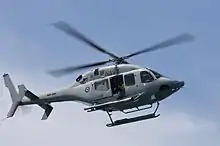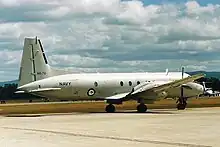| 723 Squadron RAN | |
|---|---|
_Airbus_Helicopter_EC135T2%252B_at_Wagga_Wagga_Airport.jpg.webp) Royal Australian Navy EC-135T2+ | |
| Active | 1952–present |
| Country | |
| Branch | Fleet Air Arm (RAN) |
| Type | Naval Aviation |
| Role | Rotary Training |
| Garrison/HQ | HMAS Albatross (Joint Helicopter School) |
| Motto(s) | Wings of the Albatross |
| Battle honours | Vietnam 1967–1971 Kuwait 1991 East Timor 1999 |
| Commanders | |
| Commanding Officer | Commander Samuel Dale |
| Aircraft flown | |
| Trainer helicopter | EC-135T2+ |
723 Squadron is a Royal Australian Navy Fleet Air Arm squadron. The squadron was first raised in 1952 and throughout its history has served operationally during the Vietnam War, the Gulf War and in East Timor. It currently operates as a helicopter training squadron and is based at HMAS Albatross at Nowra, New South Wales.
History
The Royal Navy's original 723 Naval Air Squadron arrived at Nowra in January 1945 after travelling from the United Kingdom on the troopship Athlone Castle. The squadron "towed drogue targets [and provided] ‘attacking aircraft’ for ship and aircraft gunnery practice, radar calibration and radar interception targets."[1] It was disbanded on May 31, 1946.
723 Squadron was first commissioned into the Royal Australian Navy (RAN) on 7 April 1952 and was equipped with one Dakota, one Wirraway, one Sea Otter and two Sea Fury aircraft.
On 11 March 1953 the Squadron took delivery of the RAN's first helicopter, a Bristol Sycamore. 723 Squadron also took delivery of the RAN's first jet aircraft, a de Havilland Vampire Mk T.34 on 18 June 1954.[2]
During the Vietnam War, personnel from the squadron operated as part of the Experimental Military Unit, a joint Australian-American helicopter assault and transport unit.[3] During the squadron's history, the battle honours "Vietnam 1967–71", "Kuwait 1991", and "East Timor 1999" have been earned.[4][5]
Current roles
723 Squadron was previously equipped with 13 Aerospatiale AS 350BA Ecureuil (Squirrel) and three Bell 429 helicopters. The Squadron is based at HMAS Albatross (NAS Nowra). The Squirrels were used for conversion training all pilots, observers and aircrew from fixed wing to rotary wing aircraft. The Bell 429 joined the Squadron in 2012 on lease from Raytheon Australia and were used for multi engine training for pilots moving onto other aircraft such as the S-70B-2 Seahawk.
It is currently active as the Australian Defence Force's helicopter training squadron operating the EC-135T2+ helicopter at the Joint Helicopter School.[6]
Aircraft




Current
Previous
- Supermarine Sea Otter
- de Havilland Tiger Moth
- Auster Autocar
- CAC Wirraway
- Bristol Sycamore
- Hawker Sea Fury
- Fairey Firefly
- Westland Scout
- de Havilland Sea Venom
- de Havilland Vampire
- Douglas C-47 Dakota
- Bell UH-1
- Bell/CAC 206B-1 Kiowa
- Westland Wessex
- Hawker Siddeley HS 748
- Agusta A109E[8]
- Aerospatiale AS 350BA Ecureuil (Squirrel)
- Bell 429
References
- ↑ "723 Naval Air Squadron". www.royalnavyresearcharchive.org.uk. Retrieved 9 August 2022.
- ↑ "723 Squadron History Part 1". Royal Australian Navy. Retrieved 4 December 2019.
- ↑ Australian Naval Aviation Museum (ANAM) (1998). Flying Stations: A Story of Australian Naval Aviation. St Leonards, NSW: Allen & Unwin. pp. 179–81. ISBN 1-86448-846-8. OCLC 39290180.
- ↑ "Navy Marks 109th Birthday With Historic Changes To Battle Honours". Royal Australian Navy. 1 March 2010. Archived from the original on 13 June 2011. Retrieved 23 December 2012.
- ↑ "Royal Australian Navy Ship/Unit Battle Honours" (PDF). Royal Australian Navy. 1 March 2010. Archived from the original (PDF) on 14 June 2011. Retrieved 23 December 2012.
- ↑ "723 Squadron". Royal Australian Navy. 3 December 2019.
- ↑ "723 Squadron". Royal Australian Navy. Retrieved 29 August 2021.
- ↑ Article from The Australian newspaper online, retrieved 2007-08-30.